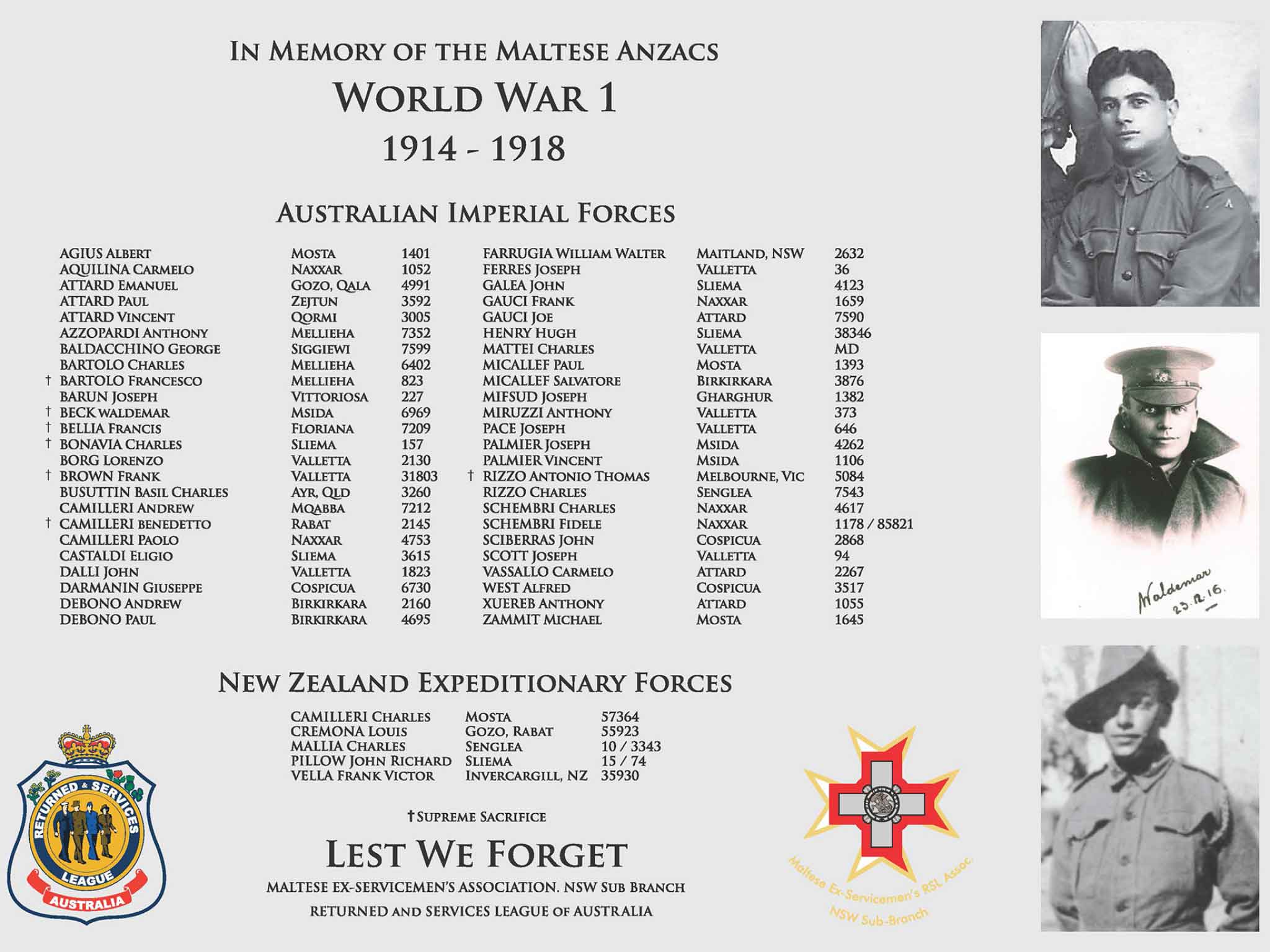LEST WE FORGET – REMEMBRANCE DAY
SERVICE MEN AND WOMEN OF DIVERSE CULTURAL BACKGROUNDS
Among the soldiers of the Australian Imperial Force (AIF) were men from first, second and third generation Illawarra settlers and migrants of diverse cultural backgrounds. Below is a list compiled of some of those ‘First Generation’ men who served during World War 1 with stories of their lives before, during and after the Great War.
FIRST GENERATION SOLDIERS
Charles ABDULLAH
Born: Mount Lebanon, Syria, in 1875
Occupation: Labourer
Address: Port Kembla
Private Charles Abdullah enlisted in Wollongong on 5 August 1917. He was 42 years of age and single. He fought on the Western Front and was awarded the British War and Victory Medal. Charles Abdullah was wounded in action in France on 11 August 1918 sustaining a back wound. After treatment for his back wound at the Casualty Clearing Station he was transported to Hospital in England. Charles Abdullah returned to Australia on 19 October 1918 and was discharged with the rank of Private on 2 February 1919 as medically unfit.
Ludwig ANDREASSEN
Born: Tonsberg, Norway, in 1893
Occupation: Labourer
Address: Jervis Bay
Private Ludwig Andreassen enlisted at the Waratah March in Wollongong on 7 December 1915. He was 23 years of age and was single. He fought at the Western Front. In 1916 Ludwig Andreassen took part in the battle for Pozieres in France and served on the Western Front until 18 September 1918 when he was wounded in action with gun shot wounds to his left hand. He was transported to England for treatment. Ludwig Andreassen was awarded the Victory Medal and the British War Medal. He returned to Australia in January 1919 and was discharged with the rank of Private on 4 September 1919.
Hypolit BRYNKEVEH (Brynkiewicz)
Born: Lodz, Poland, in 1888
Occupation: Cotton worker (in Poland) Miner, Greaser, Brickyard Labourer (in Australia)
Address: Corrimal
Hypolit Brynkeveh enlisted at Corrimal on 27 March 1916 as a Private. He was 28 years of age and single. Hypolit Brynkeveh joined the Army as a ‘Polish subject’ and embarked from Sydney for England on 24 August 1916 and on 1 January joined the 45th Battalion in France. Hypolit Brynkeveh saw service at the Western Front. On 18 June 1918 he was suffered gun shot wounds to his head and it took him a month to recover in hospital upon which he then returned back to service on 20 July 1918. Hypolit Brynkeveh (Brynkiewicz) returned to Australia in June 1919 and was discharged on 13 September 1919 with the rank of Lance Corporal.
Peter COMENSOLI
Born: Italy in 1877
Occupation: Miner
Address: Corrimal
Peter Comensoli arrived in Australia around 1893 and lived in Corrimal with his sister Mary. He worked at the local colliery as a miner. Peter Comensoli enlisted on 6 January 1916 as a Sapper. He was 38 years of age and single. He embarked from Sydney on board HMAT A69 Warilda on 22 May 1916 and arrived in England on 18 July 1916. On 30 September 1916 he joined the 1st Tunnelling Company in France. During the first half of 1917 he was sick with trench fever and after he recovered returned to service as a sapper on the Western Front. Peter Comensoli was awarded the British War Medal, Victory Medal and was recommended for the Military Medal. He returned to Australia on 20 April 1919 and was discharged on 26 July 1919 with the rank Sapper.
Gustaf DAHLSTROM
Born: Gotherberg, Sweden in 1891
Occupation: Motor Driver
Address: Woonona
Gustaf (George) Dahlstrom was born in Sweden in 1891. Before arriving in Australia, he served in the Royal Swedish Navy. After coming to Australia he lived at Woonona where he worked as a motor driver. Gustaf Dahlstrom enlisted on 29 August 1914 in Sydney with the rank of Private. He was 23 years of age. Gustaf Dahlstrom left Sydney for Egypt on 20 October 1914 onboard HMAT A14 Euripides. On 25 April 1915 he arrived at Gallipoli. Between 25 and 30 April 1915 he was wounded in the right shoulder and required hospital treatment in England. On 16 August 1917 Gustaf Dahlstrom returned to Gallipoli and shortly after became ill and on 21 August 1915 was admitted to the 3rd Field Ambulance. In November 1915 Gustaf became seriously ill with septic throat and pyrexia. He returned to Australia in March 1916 and was discharged as medically unfit on 27 July 1916. Gustaf Dahlstrom was awarded the British War Medal, Victory Medal and the 1914/1915 Star. Gustaf (George) Dahlstrom died in 1964.
Mitrofan KOROPETS
Born: Dobrotov Ukraine (Russian Empire) 1889
Occupation: Miner
Address: Helensburgh
Mitrofan Koropets enlisted on 14 January 1916 as a Sapper. He was 27 years of age. After enlistment Mitrofan Koropets embarked from Sydney on HMAT A38 Ulysses on 20 January 1916 as part of the 1st Tunnelling Mining Corps where he served on the Western Front as a tunneller. From 17 October to 6 December 1917 he became ill and was treated in hospital. Then on 14 March 1918 he was wounded in action by gas with his eyes most affected. Unable to continue serving he was returned to Australia in March 1919 and was discharged medically unfit in September 1919 with the rank of Sapper. He was awared the British War Medal and the Victory Medal. Mitrofan Koropets died in Sydney on 1 April 1920.
Christian OLSEN
Born: Borgre, Norway in 1888
Occupation: Wardsman at Wollongong Hospital
Address: Campbell Street, Wollongong
Christen Olsen enlisted on 25 July 1915 as a Private. He was 26 years of age and single. Christen Olsen embarked from Sydney to Egypt on HMAT A61 Kanowna on 22 December 1915. He saw service in Egypt at the Dermatological Hospital until September 1916 when he was returned to Australia to undergo a hernia operation because of an injury sustained by falling when lifting a patient in the hospital in Egypt. After he recovered from his operation Christen Olsen left Sydney on 11 April 1917 and went to England where he served in the Medical Corps. He was awarded the British War Medal and Victory Medal. Christen Olsen returned to Australia on 18 July 1919 and was discharged on 13 December 1919 with the rank of Private. In 1942 Christen Olsen enlisted to fight in World War 2.
Frank PYZIAK
Born: Widzew, Poland in 1890
Occupation: Orchardist
Address: Wollongong
Frank Pyziak arrived in Australia from America in 1909 and was naturalised in 1914. In 1916 he lived in Wollongong and worked as an orchardist. Frank Pyziak enlisted on 8 March 1916 as a Private. He embarked from Sydney to England on HMAT A47 Mashobra and in February 1917 he joined the 53rd Battalion in France and served on the Western Front. Frank was wounded twice in action, once on 27 March 1918 where he received gun shot wounds to his shoulder and on 1 September 1918, this time with gun shot wounds to his right leg. The wounds required Frank to be hospitalised and on both occasions he was sent to England for treatment. Frank Pyziak was awarded the British War Medal and Victory Medal. He returned to Australia on 5 January 1919 and was discharged medically unfit on 13 October 1919 with the rank of Private. Frank Pyziak enlisted once again and saw service during World War 2 from 3 Janaury 1941 to 1 November 1944. After World War 2 Frank Pyziak lived in Wollongong where he died.
Second and Third Generations
Edward John HEININGER born in DAPTO
Cyril Patrick HEININGER born in DAPTO
Frederick Charles BARLOGIO born in BULLI
Joseph BARLOGIO born in WOLLONGONG
John James BARLOGIO born in BULLI
Carlton Norman CHIE born in DAPTO
Charles Vivian ZIEMS born in ALBION PARK
James ORVAD born in WOLLONGONG
MALTESE ANZACS FIRST WORLD WAR HONOUR ROLL
This memorial is located at the George Cross Falcons Community Centre in Cringila and is inscribed with an honour roll of servicemen from the First World War who were of Maltese descent. The plaque also contains three photographs of veterans one of which is of Private Waldemar Beck, who on 3 December 1916 sailed for Devonport in England from Fremantle in Western Australia, on board HMAT A35 Berrima. He died of wounds in France on 6 July 1918.

 (https://www.warmemorialsregister.nsw.gov.au/memorials/maltese-anzacs-first-world-war-honour-roll)
(https://www.warmemorialsregister.nsw.gov.au/memorials/maltese-anzacs-first-world-war-honour-roll)
War Memorial in Kiama
Lao Roman POTOSKI – possibly Polish. Roll of Honour 1961, 1917, & 1918 listed soldiers in active service: Lao Roman POTOSKI and D. DEWRSKI – possibly Polish
Russian Born Servicemen Enlisted in the AIF
During the First World War over a thousand Russian-born servicemen enlisted in the Australian Imperial Force (AIF). They were the largest national group in the AIF after British, New Zealand and Canadian born servicemen. Besides ethnic Russians, these ANZACs included members of a score of different ethnic groups born within the borders of the Russian Empire. In 1915 the Russian Empire was a multinational state where ethnic Russians compromised only 50% of the population. The largest groups were Finns, Latvians, Estonians, Baltic Germans, Lithuanians, Ukrainians, Belarussians, Poles and Jews.
Origins of Remembrance Day
(Source: Australian War Memorial)
At 11 am on 11 November 1918 the guns on the Western Front fell silent after more than four years of continuous warfare. The allied armies had driven the German invaders back, having inflicted heavy defeats upon them over the preceding four months. In November the Germans called for an armistice (suspension of fighting) in order to secure a peace settlement. They accepted allied terms that amounted to unconditional surrender.
The 11th hour of the 11th day of the 11th month attained a special significance in the post-war years. The moment when hostilities ceased on the Western Front became universally associated with the remembrance of those who had died in the war. This first modern world conflict had brought about the mobilisation of over 70 million people and left between 9 and 13 million dead, perhaps as many as one-third of them with no known grave. The allied nations chose this day and time for the commemoration of their war dead.
On the first anniversary of the armistice in 1919 two minutes’ silence was instituted as part of the main commemorative ceremony at the new Cenotaph in London. The silence was proposed by Australian journalist Edward Honey, who was working in Fleet Street. At about the same time, a South African statesman made a similar proposal to the British Cabinet, which endorsed it. King George V personally requested all the people of the British Empire to suspend normal activities for two minutes on the hour of the armistice “which stayed the worldwide carnage of the four preceding years and marked the victory of Right and Freedom”. The two minutes’ silence was popularly adopted and it became a central feature of commemorations on Armistice Day.
Bibliography:
- https://russiananzacs.net/
- https://www.anu.edu.au/news/all-news/russian-roots-are-hidden-in-anzac-history
- Illawarra Remembers 1914-1918 – http://www.illawarraremembers.com.au/node
- Russian Anzacs – https://russiananzacs.net/
- https://www.awm.gov.au/collection/C388347
- https://lookingbackwithmickroberts.wordpress.com/2020/04/24/wollongong-war-memorial-dedication/
- https://www.monumentaustralia.org.au/themes/conflict/multiple/display/23833-wollongong-war-memorial-arch/
- https://trove.nla.gov.au/newspaper/article/102744896?searchTerm=dewrski
- https://webarchive.nla.gov.au/awa/20180315084809/http://illawarraremembers.com.au/node/4832
- https://www.awm.gov.au/commemoration/remembrance-day/traditions
Researcher: Zofia Laba



